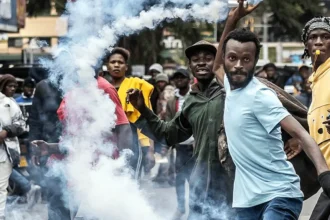A wave of youth-led demonstrations across Madagascar has triggered the country’s most serious political crisis in over 15 years. Sparked by widespread blackouts and water shortages, the Madagascar protests have rapidly evolved into a broader demand for political reform. In response, President Andry Rajoelina dismissed his entire cabinet, though the move failed to calm public outrage.
Thousands have taken to the streets in cities nationwide, accusing the government of neglecting essential services. The protests, led largely by a digital youth movement called Gen Z Mada, have gained national momentum, drawing support from unions, civil society groups, and opposition leaders.
What Sparked the Unrest?
The unrest began after the arrest of two local politicians who had planned a peaceful protest in the capital, Antananarivo. Their detention, seen as an attempt to suppress dissent, ignited fury among citizens already frustrated by ongoing power and water cuts.
State-owned utility Jirama has been at the center of public anger. Daily outages lasting several hours have disrupted homes, schools, and businesses. Many blame mismanagement and corruption within the company for the continuing crisis. Here is the link to our article on Trump Protest Plans.
How Did Gen Z Get Involved?
A youth movement known as Gen Z Mada quickly mobilized online. Using platforms like TikTok and Facebook, the group coordinated citywide demonstrations. After early successes, they formed a joint committee with civil society groups and local leaders to organize further actions.
Protesters now wave banners demanding accountability and better governance. Many call for the president’s resignation, and the slogans have shifted from service complaints to calls for full political change.
What Are Protesters Demanding?
Although there is no formal manifesto, the demands are clear. Demonstrators want President Rajoelina to resign and accept responsibility for those killed during security crackdowns. They also seek reforms in the National Assembly, dissolution of the election commission, and the top court.
Opposition figures, including former President Marc Ravalomanana and Siteny Randrianasoloniaiko, have refused to join the current administration. Instead, they support the movement, calling for deep institutional reforms. Here is the link to our article on Transgender Protest Vandalism.
What Was the Government’s Response?
In an attempt to ease tensions, President Rajoelina removed his government, accusing ministers of failing to perform. He also promised new energy funding from the World Bank and compensation for businesses affected by looting.
Despite these moves, public anger remains high. Security forces have maintained a heavy presence in key cities, using tear gas and water cannons to disperse crowds. A curfew was imposed in the capital following incidents of looting, including damage to the finance ministry.
What Is Daily Life Like in Madagascar?
Life in Madagascar remains challenging. The World Bank estimates that 75% of the population lives below the poverty line. Only one in three people has access to electricity, according to international financial data.
Protesters say the situation is growing worse. Job insecurity, rising costs, and failing infrastructure have pushed many, especially the youth, to the streets in desperation.
Is the President’s Position at Risk?
Analysts suggest the unrest could deepen if the government relies on repression rather than reforms. Political experts note that a tipping point could come if the military refuses orders to suppress protests.
The government, however, remains firm. Dismissing UN casualty figures and labeling them misinformation, authorities claim unauthorized gatherings are threats to public order.
Despite warnings of economic fallout and civil unrest, President Rajoelina has insisted that democratic order must be preserved without foreign interference.
Final Thoughts
The Madagascar protests reflect a deeper national crisis rooted in youth frustration, economic hardship, and institutional decay. While the government has taken initial steps to calm unrest, the calls for systemic change continue to grow louder. With Gen Z at the forefront, the movement signals a generational shift demanding not just services but a new vision for leadership in Madagascar.








